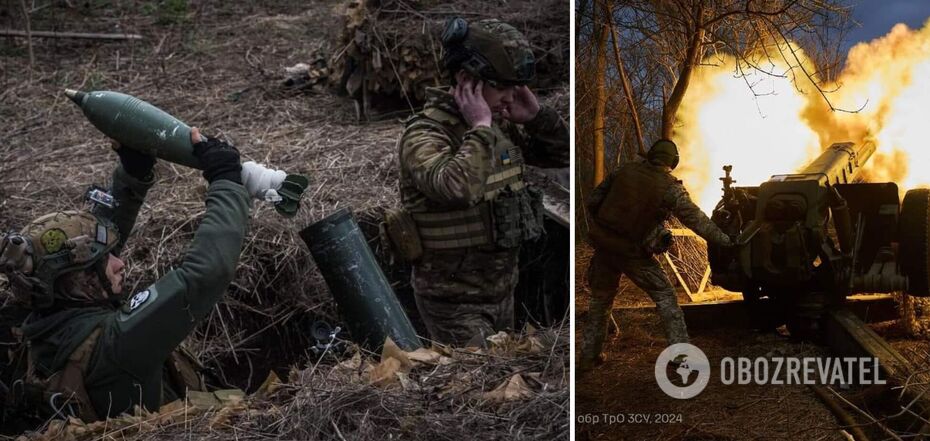War in Ukraine
Ukrainian Armed Forces urgently need US assistance to successfully repel Russian offensive - ISW
The situation on the battlefield in eastern Ukraine has deteriorated significantly in recent days. The Russian occupiers are advancing on three fronts, and it is becoming increasingly difficult for Ukrainian soldiers to hold the line amid a shortage of ammunition and air defense equipment and the almost complete absence of military assistance from the United States.
And if the United States does not resume assistance, there is a high threat that even poorly trained and prepared Russian occupation forces will be able to succeed in the war against Ukraine. This was warned by the Institute for the Study of War (ISW).
Analysts noted that Russian troops are currently operating at the operational level in three areas. They do not reinforce each other, but the occupiers have the opportunity to concentrate on gaining tactical achievements in any sector of their choice.
This was also stated by the Commander-in-Chief of the Armed Forces of Ukraine, Colonel General Oleksandr Syrsky, who on April 13 noted a significant escalation of the situation on the eastern front in recent days. According to him, the Russians are conducting mechanized attacks at the Liman, Bakhmut and Pokrovsk directions.
The Russian offensive is facilitated by dry and hot weather, which has made it easier for enemy heavy equipment to advance. In addition, despite significant losses, the Russians are bringing new units to eastern Ukraine in an attempt to achieve tactical success.
"Russia's efforts on the Liman, Chasiv Yar and Pokrovske directions pursue important operational objectives, but these operations do not support each other, and Russian forces still seem to be alternating between different directions rather than leaning toward all three at any given time," the analysts noted.
Experts noted that during the previous two years of full-scale Russian aggression, Ukrainian troops successfully repelled Russian offensives of this operational level, not least because of the resources provided by the US Armed Forces. So at some point, Russia was forced to end its attempts to advance before achieving operationally significant results.
Now, when Ukrainian troops are suffering from a significant shortage of artillery shells and air defense systems, which are critical to defense, the Russians have decided to take advantage of this.
"The Russian military command probably believes that Ukrainian forces will not be able to defend themselves against current and future Russian offensives due to delays or complete cessation of US military assistance. Recently, Russian troops have been periodically shifting their attention between offensive operations on the Liman, Chasiv Yar, and Pokrovske directions. Initially, in early 2024, Russian troops prioritized the capture of Avdiivka, along with simultaneous but less intense operations on the Kupiansk-Svatove-Kreminna line, then concentrated on the Liman direction, slowing down somewhat near Avdiivka, and in March-April 2024, they intensified efforts to capture Chasiv Yar," the article says.
Analysts believe that the occupying Russian forces lack the strength to conduct more than one effective large-scale operational operation at a given time. This problem has been recorded since the beginning of the full-scale invasion. However, now the occupiers have been able to alternate several offensive efforts to "stretch" Ukraine's forces in the face of the lack of Ukrainian artillery and air defense.
This scheme even allowed some Russian units in less intense areas to rest and recover while Ukrainians were attacked by units that had rested earlier or had recently received reinforcements.
Further, the Russian command can intensify its efforts in another operational area at any time, forcing the Ukrainian Defense Forces to redistribute their defense resources in the theater and create vulnerabilities that Russian forces can exploit.
According to ISW, the occupiers are creating operational and strategic level reserves that will not only support the current offensive operations in Ukraine, but also likely launch the announced offensive in the spring and summer.
And, according to analysts, these reserves are unlikely to be ready to act as first-echelon penetration or second-echelon exploitation forces and to be able to conduct large-scale mechanized assaults in 2024, as long as Ukrainian forces have the means to counter them. So Russian forces are likely to use them to re-enforce or reinforce existing formations and continue the infantry-led grind with occasional limited mechanized pushes in a chosen direction at key moments.
Much of this depends on what Ukraine's biggest ally, the United States, does.
"If the United States does not resume its assistance to Ukraine, and if Ukrainian forces continue to lack critical artillery and air defense munitions, even poorly trained and ill-equipped Russian forces will be able to conduct successful offensives," ISW concluded.
Earlier, ISW said that it was the West's indecision that created the possibility of a new offensive for Russia. The Kremlin is trying to hinder the development of the Ukrainian defense industry, which has the potential to reach a level where it can meet its own needs in the future. The occupiers are doing this, in particular, by destroying the Ukrainian energy sector.
The growth of Russian activity is also facilitated by delays in the provision of Western aid, which has opened up the possibility for Russia to launch a strike campaign against Ukraine and a new offensive.
Only verified information is available on our Telegram channel OBOZ.UA and Viber. Do not fall for fakes!




























